Unlike other dogs, an Indian Spitz is much more likely to get a Skin problem sooner or later. As of my experience, every 1 in 3 Indian Spitz gets problems with their skin like itching and scratching. Skin Infections in Indian Spitz dogs are very common. If you have noticed your dog itching and red bumps on the skin or small red circles or inflation then you should know everything about them. Because prevention is better than cure. If you know what is the Indian Spitz Skin problems and what causing it then you might be able to prevent it from going worse and at some point, you can cure it easily at home.
Some Skin Infections in Indian Spitz are curable at home, Today in this post, we will talk about common and rare types of Indian Spitz skin diseases.
Skin Problems in Indian Spitz Dogs
Indian Spitz dogs are known to be prone to certain skin problems. Some of the common skin issues that Indian Spitz dogs may experience include:
Flea infestations: Fleas are common parasites that can cause skin irritation, itching, and hair loss in dogs. Flea infestation is a severe stage of skin problems. You will see a lot of fleas and your dog is getting weaker everyday and developing many skin problems.
Allergies: Indian Spitz dogs may develop allergies to food, flea bites, or environmental factors like pollen, dust, or grass. Allergies can cause itchy skin, rashes, and hair loss. If your dog is allergic to flea then it will get red bumps, flaky round spots, or even some dirty red round spots which can be washed away with a wet towel.
Skin Infections: Skin Problems in Indian Spitz dogs may develop skin infections caused by bacteria, fungi, or yeast. Symptoms may include redness, itching, hair loss, and scabs.
Hot Spots: Hot spots are a type of skin infection in Indian Spitz Dogs that develops when the skin becomes irritated and inflamed. They are often caused by scratching or licking and may appear as a red, moist patch of skin.
Mange: Mange is a skin condition caused by mites that burrow into the skin, causing intense itching and hair loss. Indian Spitz dogs are particularly prone to a type of mange called Demodectic mange.
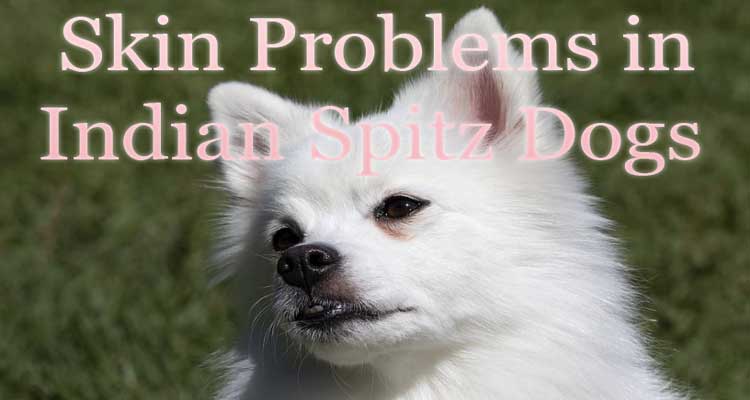
Other Problems
Food allergies: Indian Spitz dogs can develop allergies to certain food ingredients, such as beef, chicken, soy, wheat, and corn. Symptoms of food allergies may include skin itching, gastrointestinal issues, and ear infections.
Environmental allergies: Indian Spitz dogs can also be allergic to various environmental factors, such as pollen, dust, and mold. Symptoms of environmental allergies may include skin itching, redness, and inflammation.
Contact allergies: Indian Spitz dogs can develop allergies to certain materials, such as rubber, plastic, or fabrics, which come into contact with their skin. Symptoms of contact allergies may include skin redness, itching, and inflammation.
Inhalant allergies: Indian Spitz dogs can also develop allergies to airborne substances, such as dust mites, pollen, and mold spores. Symptoms of inhalant allergies may include coughing, sneezing, and respiratory distress.
Some of these Indian Spitz Skin problems are very common and not so dangerous. If you take care of them at an early stage then these skin problems in Indian Spitz dogs can be resolved easily. In the blow section, I will explain each one briefly and give you some quick precautions that you can take at an early stage. But always remember, if your dog is having a severe attack on the skin then a vet visit is necessary. They will provide you medication that will help your Indian Spitz skin infection recover fast.
Read About Rabies on WHO(World Heath Organisation)
Skin Allergy in Indian Spitz
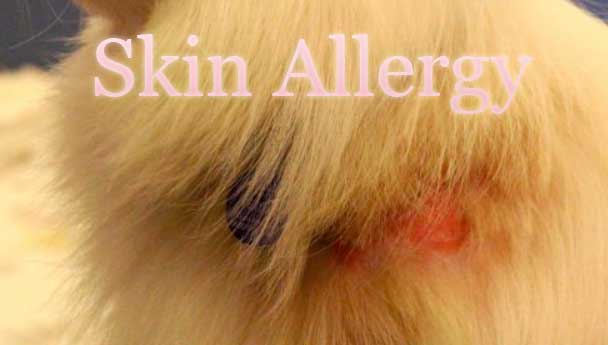
Indian Spitz dogs, like any other breed of dog, can suffer from skin allergies. Some common skin allergies that affect Indian Spitz dogs are:
Flea allergy dermatitis: Indian Spitz dogs can be highly allergic to flea bites, which can cause severe itching, hair loss, and skin irritation. In the early stage, your will be able to see your dog itching so much and the areas have bump or red circles, some times these red circles can be removed with wet cloth. This one problem i faced myself with my Indian Spitz dog. It needs some medication, but if you are delaying it, here are some Home Remedy you can use to Prevent from Flea Allergy Reactions.
Food allergies: Certain food ingredients like chicken, beef, and dairy products can trigger allergic reactions in Indian Spitz dogs, leading to skin rashes, itchiness, and ear infections.
Atopic dermatitis: This is a genetic condition that causes hypersensitivity to environmental allergens like pollen, dust mites, and mold. It can cause intense itching, redness, and skin infections in Indian Spitz dogs.
Contact dermatitis: Indian Spitz dogs can develop an allergic reaction to chemicals, fabrics, or materials that come into contact with their skin. This can cause skin rashes, blisters, and itching.
More: Indian Spitz Dog Price
Hot Spots in Indian Spitz Dogs
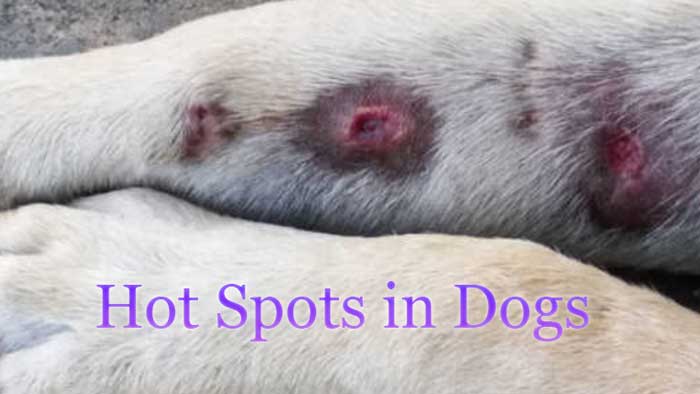
Hot spots, also known as acute moist dermatitis, are a common skin problems in Indian Spitz Dogs that can affect dogs. They are areas of skin inflammation and irritation that can be very itchy and painful for the dog. Hot spots typically appear as moist, red, and sometimes scabby lesions on the dog’s skin, and they can occur anywhere on the body.
Hot spots can be caused by a variety of factors, including allergies, insect bites, poor grooming, or underlying skin infections. Dogs who are prone to hot spots may develop them repeatedly, and the condition can be difficult to manage if the underlying cause is not addressed.
If you suspect that your dog has a hot spot, it is important to have them evaluated by a veterinarian. Treatment may include antibiotics to control any underlying infection, topical medications to reduce inflammation and itching, and strategies to prevent further irritation and self-trauma to the affected area.
How to Take Care of Hot Spots
Even infections like Hot Spots can be prevented or at least we can manage to let them become worst. If your Indian Spitz dog has hot spots, there are several steps you can take to help manage the condition and promote healing. Here are some tips for taking care of hot spots in dogs:
Keep the affected area clean and dry: Gently clean the area around the hot spot with mild-temperature water, and pat it dry with a clean towel. Avoid using harsh soaps or antiseptics, as these can further irritate the skin.
Trim the fur around the hot spot: This will help to keep the area clean and dry, and will also prevent hair from matting around the lesion.
Apply a topical medication: Your veterinarian may prescribe a topical medication, such as a corticosteroid cream or an antibiotic ointment, to help reduce inflammation and control any underlying infection. If you do not have any ointment yet, then use raw haldi(turmeric) on the place.\
Also, prevent your dog from licking that area. How? well, you can use a cone of shame otherwise you can just keep eye on him. Covering the hot spot is not a good idea but it can help a little. But remember, only for a little time. Most of the time it has to stay open.
To cure a hot spot in Indian Spitz dogs, a Veterinarian visit is important. So, please visit and get the proper medication. Follow your veterinarian’s instructions for how to apply the medication, and be sure to wear gloves to protect your own skin.
Other Things you can do
Use an Elizabethan collar: If your dog is licking or scratching at the hot spot, an Elizabethan collar (also known as a (“cone of shame”) can help prevent further self-trauma and promote healing.
Address the underlying cause: Hot spots are often caused by allergies, fleas, or other skin irritants. Work with your veterinarian to identify and address the underlying cause of your dog’s hot spots to help prevent future episodes.
Remember, hot spots can be a painful and uncomfortable condition for your dog, so it’s important to seek veterinary care if you suspect that your dog has hot spots. With proper treatment and care, most hot spots can be managed and resolved within a few weeks.
Mange Skin Infection in Indian Spitz Dogs
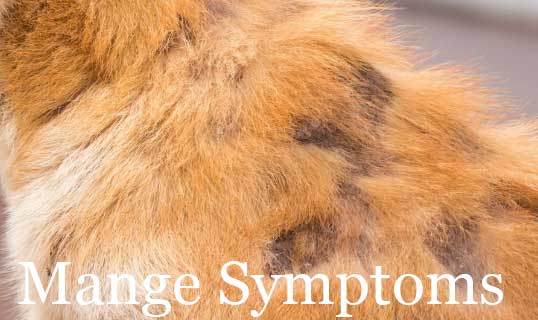
Mange is a skin condition that can affect dogs, including Indian Spitz dogs. It is caused by mites that burrow into the dog’s skin and can cause itching, redness, and hair loss. There are two main types of mange that can affect dogs:
Demodectic mange: This type of mange is caused by a mite called Demodex canis, which is a normal inhabitant of a dog’s skin. However, in some cases, the mite can overpopulate and cause skin irritation and hair loss. Demodectic mange is more common in young dogs and dogs with weakened immune systems.
Sarcoptic mange: This type of mange is caused by a mite called Sarcoptes scabiei, which burrows into the dog’s skin and can cause intense itching and hair loss. Sarcoptic mange is highly contagious and can be spread to other animals and humans.
Symptoms of mange skin problems in Indian Spitz dogs may include hair loss, itching, redness, and scaly or crusty skin. If you suspect that your Indian Spitz dog has mange, it is important to have them evaluated by a veterinarian. Treatment for mange may include topical or oral medications to control the mite population and manage skin inflammation. Your veterinarian may also recommend bathing your dog with a medicated shampoo to help soothe their skin and reduce itching. In some cases, additional treatments or supportive care may be necessary depending on the severity of the mange and any underlying health conditions.
If your Indian Spitz dog has mange:
Here are some steps you can take if your Indian Spitz dog has mange-
Prevent the spread of mange: Mange can be contagious, so it’s important to take steps to prevent the condition from spreading to other animals or humans. This may include isolating your dog from other pets, washing bedding and other items that may have come into contact with the mites, and practicing good hygiene to avoid spreading the condition to yourself or other family members.
Provide supportive care: You can help to soothe your dog’s skin and minimize their discomfort by providing supportive care at home. This may include bathing your dog with a medicated shampoo, applying soothing creams or ointments, and using an Elizabethan collar to prevent excessive scratching or licking.
Visit your veterinarian: Your veterinarian can diagnose mange and recommend a treatment plan based on the type and severity of the condition. Treatment may include medications, such as topical or oral anti-parasitic drugs, antibiotics, or anti-inflammatory medications.
Follow your veterinarian’s instructions: Be sure to follow your veterinarian’s instructions carefully for administering medications and caring for your dog’s skin. Depending on the severity of the mange, treatment may need to be repeated or continued for several weeks or months.
Remember, mange can be a serious condition that requires prompt treatment and care. By working closely with your veterinarian and providing supportive care at home, you can help your Indian Spitz dog to recover from mange and enjoy good skin health.
79 Facts About Indian Spitz Dogs
Flea Skin infection in Indian Spitz Dogs
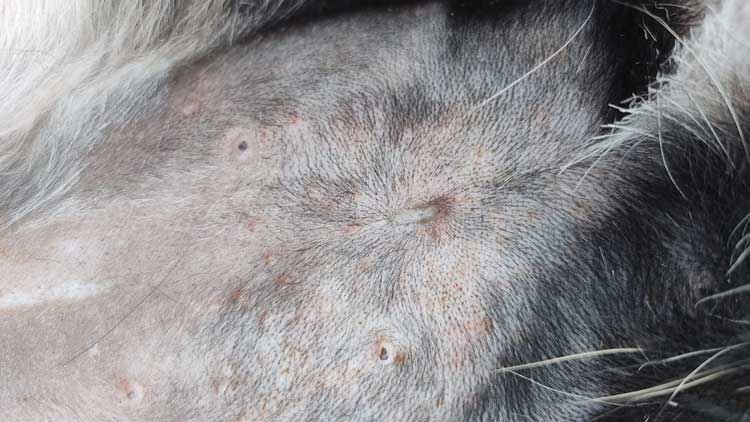
Flea infection in Indian Spitz dogs is a common parasitic condition caused by fleas, which are small, wingless insects that feed on the blood of animals, including dogs. Fleas can cause a number of problems for dogs, including itching, irritation, and skin infections. Here are some important things to know about flea infections in Indian Spitz dogs:
It is a sever type of condition when many fleas makes home in your dog’s fur. It will make your dog weak and give him a lot of skin problems in Indian Spitz dogs.
Causes: Flea infections are caused by flea bites, which can lead to itching and irritation. Fleas can also transmit diseases and parasites, such as tapeworms to dogs.
Symptoms: Symptoms of flea infections in Indian Spitz dogs may include excessive scratching, biting, or licking of the skin, red or irritated skin, scabs or bumps on the skin, hair loss, and flea dirt (tiny black or brown specks that resemble pepper flakes) in the dog’s fur.
Prevention and Treatment:
Flea infections can be prevented by using flea preventatives, such as topical medications, collars, or oral medications, as recommended by your veterinarian. It is also important to keep your Indian Spitz dog’s environment clean and free of fleas by regularly vacuuming carpets and upholstery, washing bedding and toys, and using flea sprays in the home as needed.
Still comb helps a lot. If your dog is in early stage then a still comb stop the infection before happening but remember, you will have to comb the dog every day. Treatment for flea infections may include topical or oral medications to kill fleas and prevent future infestations. Your veterinarian may also recommend supportive care, such as medicated baths or creams, to soothe your dog’s skin and reduce itching and irritation.
If you suspect that your Indian Spitz dog has a flea infection, it is important to seek veterinary care. Flea infestations can be uncomfortable for your dog and can lead to more serious health problems if left untreated. With proper treatment and prevention, however, you can help to keep your Indian Spitz dog free of fleas and healthy.
FAQs-Indian Spitz Dog Skin Probems
What are the common skin problems that Indian Spitz dogs face?
Indian Spitz dogs are prone to skin problems such as allergies, dry skin, hot spots, fungal or bacterial infections, and flea or tick infestations.
How can I tell if my Indian Spitz has a skin problem?
Some common signs of skin problems in Indian Spitz dogs include excessive scratching or licking, redness, bumps or lumps on the skin, hair loss, flakiness or dryness, and foul odor.
What are the signs of skin allergies in Indian Spitz dogs?
The signs of skin allergies in Indian Spitz dogs include itchiness, redness, swelling, and inflammation of the skin. Other symptoms may include hair loss, hot spots, and secondary bacterial or fungal infections.
Can Indian Spitz dogs get fungal or bacterial skin infections?
Yes, Indian Spitz dogs can get fungal or bacterial skin infections. These infections may be caused by an overgrowth of bacteria or fungi on the skin, or by a weakened immune system.
How can I prevent my Indian Spitz from developing skin problems?
To prevent skin problems in Indian Spitz dogs, it is important to maintain good hygiene, provide a healthy diet, and regularly groom your dog. You can also protect your dog from fleas and ticks by using appropriate preventive treatments.
Are there any particular grooming routines I should follow to keep my Indian Spitz’s skin healthy?
Regular grooming routines for Indian Spitz dogs should include brushing the coat, bathing with a mild shampoo, and cleaning the ears and teeth. It is also important to trim the nails and check for any signs of skin problems during grooming.
How can I treat my Indian Spitz’s skin problems?
The treatment for Indian Spitz skin problems depends on the underlying cause. In some cases, a change in diet or medication may be necessary. Your veterinarian may also recommend topical treatments or antibiotics for bacterial or fungal infections.
Are there any home remedies I can use to treat my Indian Spitz’s skin problems?
While there are some home remedies that can help with mild skin problems, it is always best to consult a veterinarian for more serious issues. Some home remedies that may help include using oatmeal or coconut oil to soothe dry skin or applying diluted apple cider vinegar to the skin to help with bacterial or fungal infections.
Can Indian Spitz dogs have sensitive skin, and if so, what should I do?
Yes, Indian Spitz dogs can have sensitive skin, which can be exacerbated by certain products or allergens. If you suspect that your dog has sensitive skin, it is important to use gentle grooming products and avoid exposure to potential allergens.
Should I consult a veterinarian if my Indian Spitz has a skin problem, or can I treat it at home?
If you are keeping an strong eye on your Indian Spitz Dog and you are sure about yourself, you can try home remedies. Sometime it is not a issue that big to visit a vet but It is always best to consult a veterinarian if your Indian Spitz has a skin problem, as some conditions may require prescription medication or other forms of treatment. Your veterinarian can help diagnose the underlying cause of the skin problem and provide appropriate treatment.
More: Best Diet for Indian Spitz Dogs
Final words: It is always important to look a good eye on your dog. As a pet parent, your responsibility is as much as having a kid. If you are seeing your Skin problems in Indian Spitz dog showing unusual symptoms then try to recognize it what is actually going on and then look for the cause. You can google it and try some prevention but you must do it in 2-3 days. If it still growing and it is more than 4-5 days, then a veterinarian visit is must.
Thank you for visiting our blog PawFactsnGuide. Write to us if you want to know anything about Skin problems in Indian Spitz dogs, We will surely help you or comment your thoughts in the comment box below.
